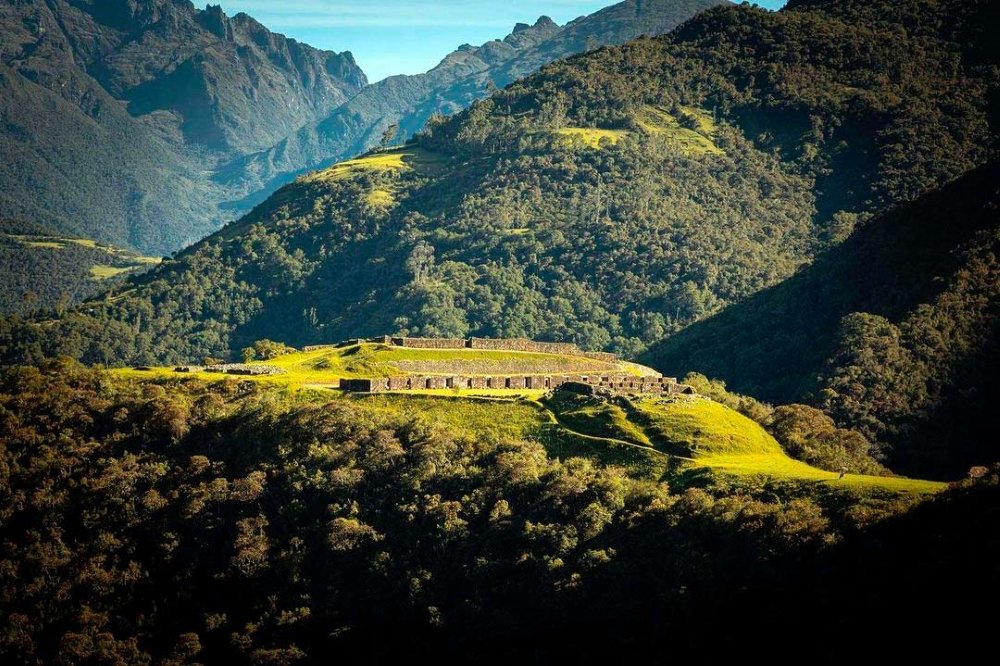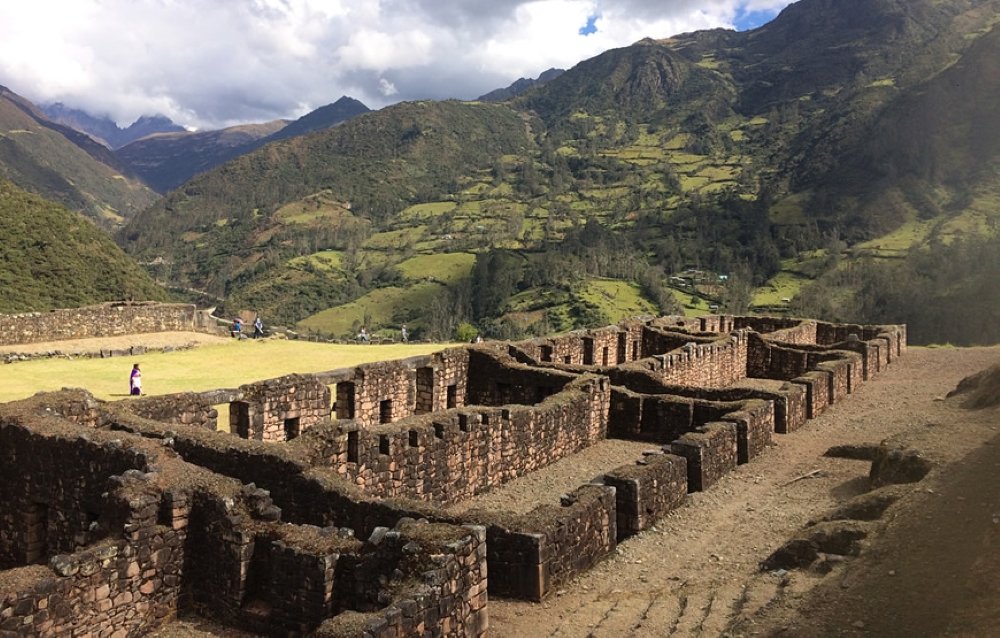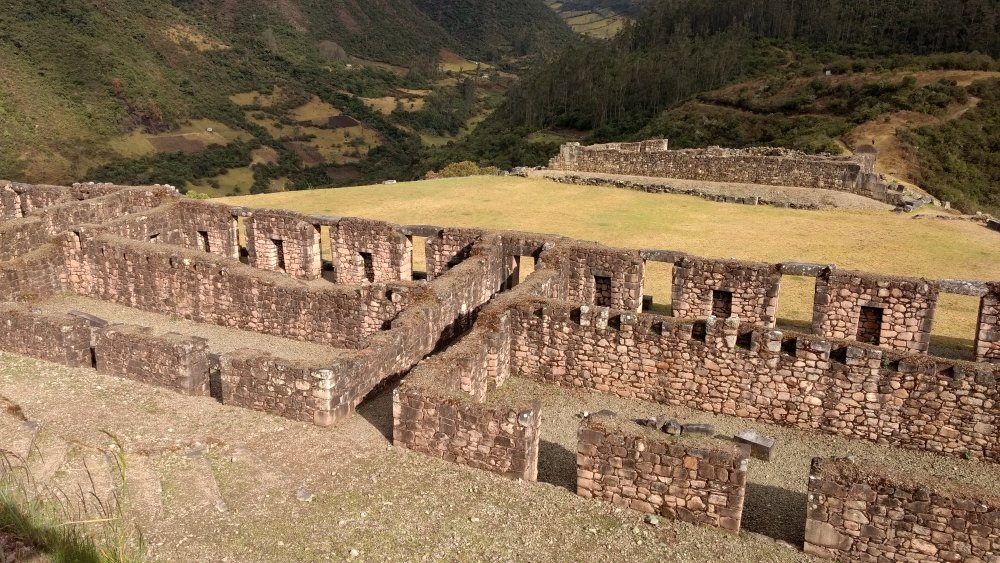Archaeological Center of Rosaspata in Vilcabamba | Cusco
The term “Rosaspata” has its origin in the Quechua language, spoken by the indigenous populations in the Andes region, including Peru. “Rosa” is a Quechua word referring to the rose plant, while “pata” means “height” or “high place”. Therefore, “Rosaspata” could be roughly translated as “high place of roses” or “height of roses”. It is possible that the name refers to the presence of rose bushes in the area or is simply a traditional name describing the geographic location of this archaeological site.
Rosaspata, located in the Cusco region of Peru, is specifically on the outskirts of the town of Vilcabamba. Vilcabamba is located in the province of La Convención, north of the city of Cusco. This region is recognized for its historical importance as the last refuge of Inca resistance during the Spanish conquest.
To access Rosaspata, you can take transportation from the city of Cusco to Vilcabamba and then coordinate with a local guide to visit the archaeological site. It is recommended to do some research beforehand and get updated information on how to get there and the conditions of the site before planning your visit.
The altitude of Rosaspata varies depending on the exact location within the Vilcabamba region. However, since Vilcabamba is in a mountainous region of the Andes, the altitude generally ranges from 2,000 to 3,000 meters above sea level. It is important to take altitude into account when planning your visit to this area, especially if you are not accustomed to high altitudes.

History of Rosaspata Archaeological Center in Vilcabamba | Cusco
The history of Rosaspata is closely linked to the history of Vilcabamba and the period of Inca resistance against the Spanish conquest. During the 16th century, after the fall of the Inca Empire to the Spanish conquistadors, the Vilcabamba region became a last refuge for the Incas who resisted colonization.
Rosaspata is considered to have been one of the significant sites in this area during this period. Archaeological evidence of Inca structures, such as agricultural terraces, dwellings and a ceremonial platform, have been discovered. These archaeological remains may have been used by Inca leaders, such as Manco Inca Yupanqui and his successor, Tupac Amaru, as part of their strategy to maintain resistance against the Spanish conquistadors.
Vilcabamba and its surroundings witnessed numerous clashes between the Incas and the Spanish during this period. Despite resistance efforts, the Incas were finally defeated and Vilcabamba fell to the Spanish in 1572, marking the end of organized Inca resistance in the region.
Today, Rosaspata is an important archaeological site that attracts visitors interested in Inca history and culture. Exploration of this site offers a fascinating window into the past and helps to better understand the struggle and resistance of the Incas against the Spanish conquest in the Vilcabamba region.
What to see in Rosaspata?
In Rosaspata, visitors can explore several ruins and archaeological structures that offer a fascinating insight into Inca history and the period of resistance against the Spanish conquest. Some of the things to see at Rosaspata include:
- Ceremonial Platform: You can find a ceremonial platform that was used by the Incas to perform important rituals and ceremonies. This structure provides a sample of the architectural ingenuity and religious importance of the Incas.
- Agricultural terraces: Rosaspata has agricultural terraces that show the ability of the Incas to cultivate in mountainous and steep terrain. These terraces were fundamental to guarantee food security for the population and show the advanced agricultural technology of the Incas.
- Dwellings: Ruins of dwellings that were once inhabited by the Inca population can also be found. These structures provide information about the daily life of the inhabitants of Vilcabamba during the resistance period.
- Panoramic views: In addition to the archaeological ruins, Rosaspata offers breathtaking panoramic views of the surrounding landscape of the Vilcabamba region. Visitors can enjoy the natural beauty of the Andes while exploring the archaeological site.
- Historical interpretation: Many visitors appreciate learning about the history of Vilcabamba and the Inca resistance through interpretive panels and the guidance of local guides, which enriches the visiting experience.
In summary, Rosaspata is a fascinating tourist destination for those interested in Inca history and culture. Exploring this archaeological site provides a unique opportunity to learn about Vilcabamba’s past and the Inca’s struggle against the Spanish conquest in the region.

How to get to Rosaspata?
Getting to Rosaspata may require some planning and logistics, as it is located in a remote area of the Vilcabamba region of Peru. Here are some common options for getting to Rosaspata:
- By bus from Cusco: You can take a bus from the city of Cusco to the city of Quillabamba, which is the closest city to Vilcabamba. From Quillabamba, you can coordinate with a local guide or take additional transportation to Rosaspata. The bus ride from Cusco to Quillabamba generally takes several hours.
- By cab or private transport: Another option is to hire a cab or private transport from Cusco to Vilcabamba. This can be a faster and more convenient method, but can also be more expensive than the bus.
- By organized tour: Many travel agencies in Cusco offer organized tours to Vilcabamba that include a visit to Rosaspata and other archaeological sites in the region. Joining a tour can be a convenient option if you prefer to leave the logistics in the hands of professionals and enjoy a guided experience.
Regardless of the method you choose, it is important to be prepared for travel conditions, including altitude, weather and the logistics of getting to Rosaspata once in the Vilcabamba region. It is also advisable to obtain up-to-date information on how to get there and site conditions before planning your visit.

Recommendations for visiting Rosaspata
Getting to Rosaspata may require some planning and logistics, as it is located in a remote area of the Vilcabamba region of Peru. Here are some common options for getting to Rosaspata:
- By bus from Cusco: You can take a bus from the city of Cusco to the city of Quillabamba, which is the closest city to Vilcabamba. From Quillabamba, you can coordinate with a local guide or take additional transportation to Rosaspata. The bus ride from Cusco to Quillabamba generally takes several hours.
- By cab or private transport: Another option is to hire a cab or private transport from Cusco to Vilcabamba. This can be a faster and more convenient method, but can also be more expensive than the bus.
- By organized tour: Many travel agencies in Cusco offer organized tours to Vilcabamba that include a visit to Rosaspata and other archaeological sites in the region. Joining a tour can be a convenient option if you prefer to leave the logistics in the hands of professionals and enjoy a guided experience.
Regardless of the method you choose, it is important to be prepared for travel conditions, including altitude, weather and the logistics of getting to Rosaspata once in the Vilcabamba region. It is also advisable to obtain up-to-date information on how to get there and site conditions before planning your visit.












